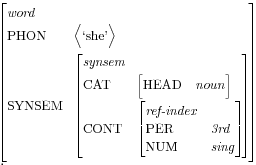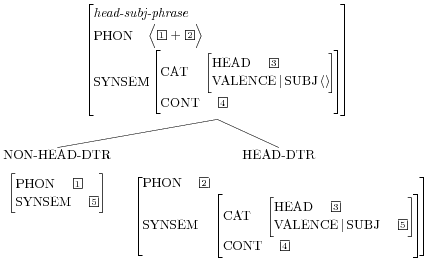Sample grammar
HPSG generates strings by combining signs, which are defined by their location within a type hierarchy and by their internal feature structure, represented by attribute value matrices (AVMs). [4] [6] Features take types or lists of types as their values, and these values may in turn have their own feature structure. Grammatical rules are largely expressed through the constraints signs place on one another. A sign's feature structure describes its phonological, syntactic, and semantic properties. In common notation, AVMs are written with features in upper case and types in italicized lower case. Numbered indices in an AVM represent token identical values.
In the simplified AVM for the word (in this case the verb, not the noun as in "nice walks for the weekend") "walks" below, the verb's categorical information (CAT) is divided into features that describe it (HEAD) and features that describe its arguments (VALENCE).

"Walks" is a sign of type word with a head of type verb. As an intransitive verb, "walks" has no complement but requires a subject that is a third person singular noun. The semantic value of the subject (CONTENT) is co-indexed with the verb's only argument (the individual doing the walking). The following AVM for "she" represents a sign with a SYNSEM value that could fulfill those requirements.

Signs of type phrase unify with one or more children and propagate information upward. The following AVM encodes the immediate dominance rule for a head-subj-phrase, which requires two children: the head child (a verb) and a non-head child that fulfills the verb's SUBJ constraints.

The end result is a sign with a verb head, empty subcategorization features, and a phonological value that orders the two children.
Although the actual grammar of HPSG is composed entirely of feature structures, linguists often use trees to represent the unification of signs where the equivalent AVM would be unwieldy.
